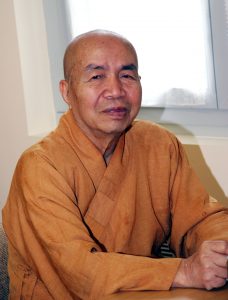Hồ Sơ Đáng Kính –Thích Tịnh Hạnh

The founder, Venerable Thích Tịnh Hạnh
淨行法師1934年生於越南寧順省。15歲時因舅父去世,體悟人生無常,乃乃發願出家,並於次年入寧順佛學院就讀。17歲時正式禮玄微和尚為師,法名是圓,法號淨行,字行備。
萬行大學畢業後,即考取越南國家公費留學資格,於1969年來臺留學,就讀國立臺灣師範大學國文研究所。1981年以《韓愈闢佛的研究》一文,取得文學博士學位。
Venerable Thich Tinh Hanh was born in 1934 in the southern Vietnam province of Ninh Thuận. When Tinh Hanh was 15 the death of his maternal uncle triggered an insight into impermanence, whereupon he resolved to go forth into the monastic life. In the following year he enrolled at the nearby Buddhist seminary, and at the age of 17 he took the monastic vows with Venerable Thich Huyen-Vi as his preceptor. At that time he received the Dharma name Shiyuan; the ordination name Tinh Hanh; and the style Xingbei.
After completing his studies at the Vạn Hạnh Buddhist University, in 1969 Tinh Hanh obtained a Vietnamese government scholarship to study abroad, whereupon he came to Taiwan and commenced graduate studies in Chinese at National Taiwan Normal University. In 1981 he completed his doctorate studies with a dissertation titled “Han Yu’s Critique of Buddhism.”
1979年成立靈山講堂,開設禪坐氣功班,接引眾生前來聽聞佛法。後陸續創辦靈山佛學研究所、《現代佛教月刊》、中國佛教學院、石碇靈山禪林寺,並舉辦國學、佛學等講座課程,將佛教朝向教育、文化、社會、經濟等各方面發展,使佛教成為適合這時代的人間佛教。1990年成立「財團法人靈山文教基金會」並擔任董事長,擴大推行文化、教育、學術等各項工作。同年,應聘為國立臺北師範學院(後改制為國立台北教育大學)副教授,成為臺灣首位在國立大學任教的博士比丘;1992年復應聘為國立中興大學中文系所專任副教授。
In 1979 he set up the Linh-Son Lecture Hall, where he opened a class in qigong and meditation. Afterwards he established the Linh-Son Buddhist Seminary, the journal Modern Buddhism Monthly, the Buddhist College of China, and the Linh-Son Zen Lin Temple. At the same time, in an effort to make Buddhism more relevant to modern society, he organized a variety of lectures and classes on various themes related to “humanistic Buddhism.” In 1990 he established the Linh-Son Culture & Education Foundation and began serving as its director. In the same year he was appointed as assistant professor at the National Taipei University of Education, thereby becoming the first Buddhist monk with a doctorate to teach at a national university in Taiwan. In 1992 he also began teaching in the Chinese Department at National Zhongxing University.
法師有感於佛教雖然傳入越南已有千年以上的歷史,佛教經典卻沒有越南文譯本,而備感遺憾,於是1993年開始推動「越譯大藏經」的志業,計劃將上千部的中文大藏經翻譯成越南文。20餘年間,除了翻譯《大正新脩大藏經》(第1冊至54冊)、《卍續藏經》、《南傳大藏經》(律部)、《古漢喃文經書》外;還翻譯了《太虛大師全集》、《印順導師全集》、《禪宗全書》(100冊)、《淨土叢書》、《海潮音文庫》、《佛光大辭典》等當代重要佛學論著與工具書。至2015年為止,共計已付梓出版五百套第1冊至第187冊《靈山法寶大藏經》。
Thich Tinh Hanh lamented the fact that, even though Buddhism had come to Vietnam over 1,000 years ago, there was still no complete collection of its scriptures in Vietnamese. Thus in 1993 he initiated a project for translating the entire Chinese Buddhist Canon into Vietnamese. Over the course of two decades this project has produced an enormous amount of translations, including the Taisho Tripitaka (volumes 1 to 54); the Xuzangjing; the Vinaya Pitaka of the Pali Canon; and the Guhannanwen jingshu. A number of modern works have also been translated, including The Collected Works of Master Taixu; The Collected Works of Master Yinshun; Encyclopedia of Chan (100 volumes); Encyclopedia of Pure Land; the Haichaoyin book series; and the Foguang Dictionary. All of these translations have been collected into a 187-volume set titled Linh-Son Dharma Treasures; up to 2015, 500 sets have been published.







